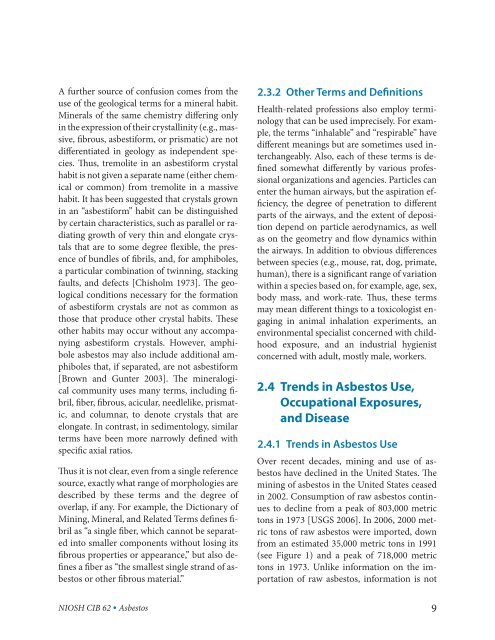Asbestos Fibers and Other Elongate Mineral Particles: State of the ...
Asbestos Fibers and Other Elongate Mineral Particles: State of the ...
Asbestos Fibers and Other Elongate Mineral Particles: State of the ...
- No tags were found...
You also want an ePaper? Increase the reach of your titles
YUMPU automatically turns print PDFs into web optimized ePapers that Google loves.
A fur<strong>the</strong>r source <strong>of</strong> confusion comes from <strong>the</strong><br />
use <strong>of</strong> <strong>the</strong> geological terms for a mineral habit.<br />
<strong>Mineral</strong>s <strong>of</strong> <strong>the</strong> same chemistry differing only<br />
in <strong>the</strong> expression <strong>of</strong> <strong>the</strong>ir crystallinity (e.g., massive,<br />
fibrous, asbestiform, or prismatic) are not<br />
differentiated in geology as independent species.<br />
Thus, tremolite in an asbestiform crystal<br />
habit is not given a separate name (ei<strong>the</strong>r chemical<br />
or common) from tremolite in a massive<br />
habit. It has been suggested that crystals grown<br />
in an “asbestiform” habit can be distinguished<br />
by certain characteristics, such as parallel or radiating<br />
growth <strong>of</strong> very thin <strong>and</strong> elongate crystals<br />
that are to some degree flexible, <strong>the</strong> presence<br />
<strong>of</strong> bundles <strong>of</strong> fibrils, <strong>and</strong>, for amphiboles,<br />
a particular combination <strong>of</strong> twinning, stacking<br />
faults, <strong>and</strong> defects [Chisholm 1973]. The geological<br />
conditions necessary for <strong>the</strong> formation<br />
<strong>of</strong> asbestiform crystals are not as common as<br />
those that produce o<strong>the</strong>r crystal habits. These<br />
o<strong>the</strong>r habits may occur without any accompanying<br />
asbestiform crystals. However, amphibole<br />
asbestos may also include additional amphiboles<br />
that, if separated, are not asbestiform<br />
[Brown <strong>and</strong> Gunter 2003]. The mineralogical<br />
community uses many terms, including fibril,<br />
fiber, fibrous, acicular, needlelike, prismatic,<br />
<strong>and</strong> columnar, to denote crystals that are<br />
elongate. In contrast, in sedimentology, similar<br />
terms have been more narrowly defined with<br />
specific axial ratios.<br />
Thus it is not clear, even from a single reference<br />
source, exactly what range <strong>of</strong> morphologies are<br />
described by <strong>the</strong>se terms <strong>and</strong> <strong>the</strong> degree <strong>of</strong><br />
overlap, if any. For example, <strong>the</strong> Dictionary <strong>of</strong><br />
Mining, <strong>Mineral</strong>, <strong>and</strong> Related Terms defines fibril<br />
as “a single fiber, which cannot be separated<br />
into smaller components without losing its<br />
fibrous properties or appearance,” but also defines<br />
a fiber as “<strong>the</strong> smallest single str<strong>and</strong> <strong>of</strong> asbestos<br />
or o<strong>the</strong>r fibrous material.”<br />
NIOSH CIB 62 • <strong>Asbestos</strong><br />
2.3.2 <strong>O<strong>the</strong>r</strong> Terms <strong>and</strong> Definitions<br />
Health-related pr<strong>of</strong>essions also employ terminology<br />
that can be used imprecisely. For example,<br />
<strong>the</strong> terms “inhalable” <strong>and</strong> “respirable” have<br />
different meanings but are sometimes used interchangeably.<br />
Also, each <strong>of</strong> <strong>the</strong>se terms is defined<br />
somewhat differently by various pr<strong>of</strong>essional<br />
organizations <strong>and</strong> agencies. <strong>Particles</strong> can<br />
enter <strong>the</strong> human airways, but <strong>the</strong> aspiration efficiency,<br />
<strong>the</strong> degree <strong>of</strong> penetration to different<br />
parts <strong>of</strong> <strong>the</strong> airways, <strong>and</strong> <strong>the</strong> extent <strong>of</strong> deposition<br />
depend on particle aerodynamics, as well<br />
as on <strong>the</strong> geometry <strong>and</strong> flow dynamics within<br />
<strong>the</strong> airways. In addition to obvious differences<br />
between species (e.g., mouse, rat, dog, primate,<br />
human), <strong>the</strong>re is a significant range <strong>of</strong> variation<br />
within a species based on, for example, age, sex,<br />
body mass, <strong>and</strong> work-rate. Thus, <strong>the</strong>se terms<br />
may mean different things to a toxicologist engaging<br />
in animal inhalation experiments, an<br />
environmental specialist concerned with childhood<br />
exposure, <strong>and</strong> an industrial hygienist<br />
concerned with adult, mostly male, workers.<br />
2.4 Trends in <strong>Asbestos</strong> Use,<br />
Occupational Exposures,<br />
<strong>and</strong> Disease<br />
2.4.1 Trends in <strong>Asbestos</strong> Use<br />
Over recent decades, mining <strong>and</strong> use <strong>of</strong> asbestos<br />
have declined in <strong>the</strong> United <strong>State</strong>s. The<br />
mining <strong>of</strong> asbestos in <strong>the</strong> United <strong>State</strong>s ceased<br />
in 2002. Consumption <strong>of</strong> raw asbestos continues<br />
to decline from a peak <strong>of</strong> 803,000 metric<br />
tons in 1973 [USGS 2006]. In 2006, 2000 metric<br />
tons <strong>of</strong> raw asbestos were imported, down<br />
from an estimated 35,000 metric tons in 1991<br />
(see Figure 1) <strong>and</strong> a peak <strong>of</strong> 718,000 metric<br />
tons in 1973. Unlike information on <strong>the</strong> importation<br />
<strong>of</strong> raw asbestos, information is not<br />
9

















